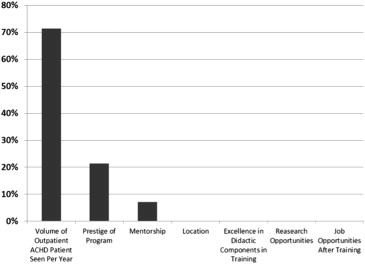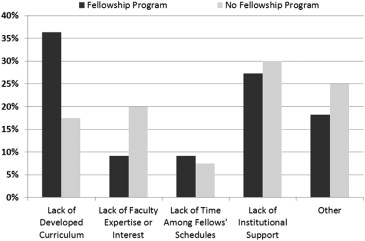Adult congenital heart disease (ACHD) presents a unique and growing patient population, but there are no data to suggest there are sufficient training programs available to train specialists to meet the needs of this population. The objective of this national survey was to determine the current status of ACHD fellowship curricula and training. An online questionnaire was provided to adult and pediatric cardiology fellowship programs to determine program demographics, status, duration, faculty teaching responsibilities, volume or patient exposure, and institutional obstacles. Of the 225 programs surveyed, 81 responded (36%). Nearly all were university affiliated (93%) with <1/3 (29%) reporting an ACHD fellowship program. Most offered either a 1- (42%) or a 2-year (47%) fellowship. ACHD fellowship funding was provided by hospital budget (68%). Half reported an increase in applicants to their fellowship. Applicants were more likely to have had previous training in adult cardiovascular medicine (56%). Respondents ranked “Volume of Outpatients/Year” and “Lack of Institutional Support” as the most important aspect of an ACHD program to applicants and greatest obstacle to ACHD training, respectively. After training, ACHD fellows obtained adult cardiology/ACHD positions (47%) and were within an academic center (88%). In conclusion, the results demonstrate a deficiency in the number of currently available ACHD fellowship programs. Measures should be taken to strengthen and standardize ACHD training to meet the increasing workforce requirements of this population.
Current estimates suggest that there are approximately 2 million adults with congenital heart disease (ACHD) in the United States with a projected growth rate of 5% per year. There are a limited number of practitioners with advanced training in the care of ACHD. There is now a greater need for ACHD subspecialty training to address the supply and demand mismatch for the care of ACHD. Through the efforts of the Adult Congenital and Pediatric Cardiology Section within the American College of Cardiology, ACHD subspecialty training is now recognized by the American Board of Internal Medicine and the American Board of Pediatrics (ABP) and has been approved for board certification. Given the limited number of advanced, high-volume pediatric cardiac surgical programs, it is likely that only a very few centers have amassed a sufficient number of patients with ACHD to provide the 2-year fellowship training program currently recommended. Furthermore, previous studies examining training patterns for adult and pediatric cardiology fellows in the United States demonstrated few centers currently providing this type of training, generating only a small number of fellows. The objective of this study was to determine the current status of ACHD fellowship curricula and training.
Methods
We surveyed 225 program directors of accredited adult cardiology and pediatric cardiology fellowship programs in North America using the updated National Resident Match Program email directory ( www.nrmp.org ). Two reminder notices followed the initial email at 2-week intervals. Survey questions investigated program demographics (geographic location, program type, and university affiliation). Additional questions that specifically focused on ACHD fellowship programs included composition and duration of training, application trends, funding, desirable characteristics of programs, obstacles to ACHD training, research, and postfellowship issues.
Statistical analysis on survey responses was performed in SPSS version 22 (IBM Corporation, New York). All data are presented as a percentage of responses given for each question in the survey. Survey responses using ranking assignments were characterized by the percentage of institutions reporting a particular response as the highest ranking reason.
Results
The survey was sent to 54 pediatric and 171 adult cardiology fellowship training programs. Of these, 81 program directors (36%) responded to the survey. Program demographics are summarized in Table 1 . One-third (29%) of respondents confirmed an established ACHD fellowship training program.
| Program Type | |
| University Affiliation | 60 (74%) |
| ACHD Fellowship | 23 (29%) |
| Geography | |
| United States: Northeast | 25 (32%) |
| United States: Southeast | 13 (17%) |
| United States: Midwest | 19 (24%) |
| United States: Northwest | 9 (11%) |
| United States: Southwest | 11 (14%) |
| Canada: Western | 1 (1%) |
| Canada: Central | 0 |
| Canada: Eastern | 0 |
Currently, most ACHD fellowship programs offer either 1- (42%) or 2-year (47%) training. A majority (63%) of these fellowship training programs have been established for <10 years and over 3/4 of programs (78%) reported training <10 ACHD fellows. Of these centers, 89% had up to 7 key faculty who were certified, trained, or had advanced training in ACHD cardiology “beyond the general cardiologist’s scope of practice.” (Key ACHD faculty were defined as spending ≥10 hours/wk throughout the year teaching, supervising, and evaluating fellows.) During ACHD fellowship training, 94% of program directors reported routine assessment of clinical competency. Program directors who included clinical competency during ACHD fellowship assessed fellows most commonly by clinical evaluation (60%), objective structured clinical examination (13%), or chart review (27%).
Exactly half of program directors (50%) reported an increase in the number of applicants to their ACHD fellowship program. To some extent, applicants were more likely to have had previous training in adult cardiovascular medicine (56%). Of those programs with ACHD fellowship training programs, funding was provided largely by hospital budget (68%). Alternate sources of funding for ACHD fellowship training included private foundation (16%), nonindustry grants (5%), and other (21%).
Respondents were asked to evaluate program characteristics considered valuable to adult congenital fellow applicants. Respondents ranked volume of outpatient adult congenital patients per year (71%) as the top characteristics that have value to fellows ( Figure 1 ). Modal analysis revealed rankings in order of importance as follows: volume of outpatient ACHD patients per year; excellence in didactic training; research opportunities; prestige of program; and job opportunities. Similarly, respondents ranked obstacles to ACHD fellowship training. Comparing programs with ACHD fellowships to those without, there were common obstacles encountered ( Figure 2 ). Lack of a developed curriculum accounted for about 1/3 of the top-ranked responses in programs that did have ACHD fellowships. Surprisingly, “Other” was selected as the top reason in a quarter of all responses. There were 3 relatively common answers given for “other,” which included lack of funding, too few patients, and young program age.






